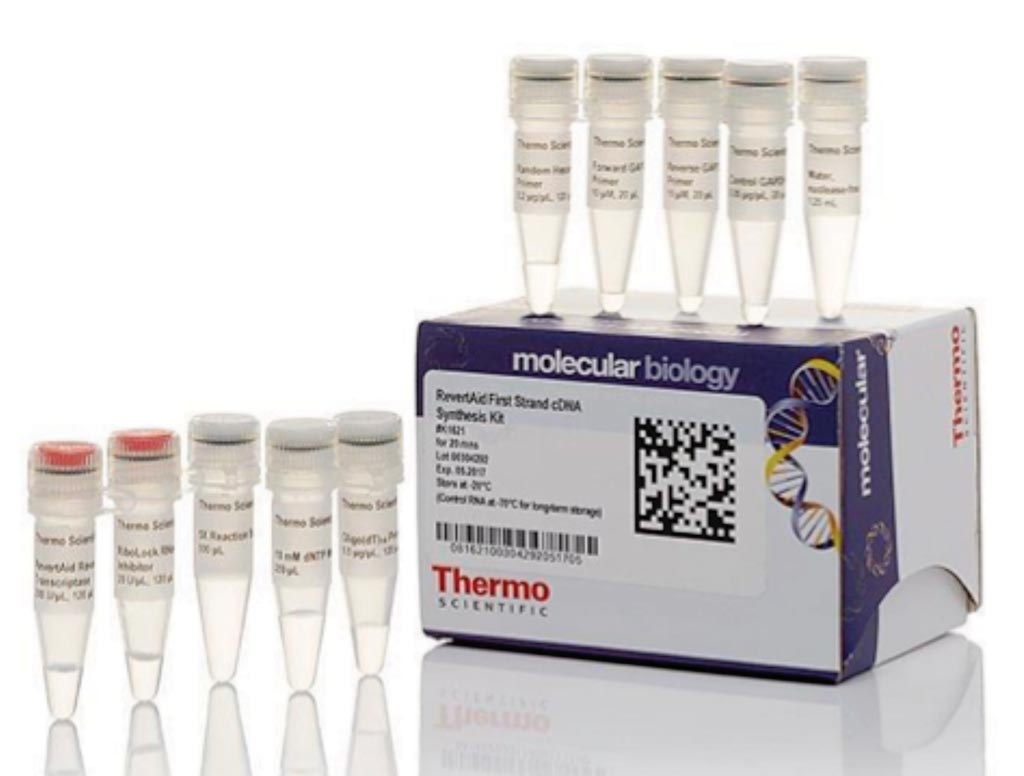Prognostic Signature Described in HPV-Positive Cell Carcinomas
By LabMedica International staff writers
Posted on 23 Jan 2019
Human papilloma virus (HPV) is an etiological agent of oropharyngeal squamous cell carcinoma (OPSCC). Patients with HPV+ OPSCC have high long-term survival rates: however, current radiation protocols are aggressive and can result in life-long morbidities, including difficulty swallowing, chronic dry-mouth, and altered speech.Posted on 23 Jan 2019
HPV+ head and neck squamous cell carcinoma (HNSCC) is considered a separate oncological entity from its HPV– counterpart that is largely tobacco driven. Its distinct etiology results in unique clinical characteristics, including affecting younger nonsmokers. Nearly all OPSCC patients present with locally advanced disease and are treated with a combination of chemotherapy and radiotherapy.

Image: The RevertAid First Strand cDNA Synthesis Kit is a complete system for efficient synthesis of first strand cDNA from RNA templates (Photo courtesy of Thermo Fisher Scientific).
A large team of scientists working with the University of Texas MD Anderson Cancer Center (Houston, TX, USA) separated clinical samples used in the study into discovery and validation cohorts. The discovery cohort was composed of the 80 OPSCCs from the Cancer Genome Atlas (TCGA) (52 HPV+ and 28 HPV–). The validation cohorts comprised the 47 HPV16+ OPSCCs and the 138 HPV16+ cervical squamous cell carcinomas (CESCCs) from TCGA.
Detection of HPV infection and HPV integration and measurement of HPV gene expression in TCGA data sets were performed by applying the VirusSeq pipeline. Tumor HPV status was established by considering an empirical cutoff of 1,000 read counts mapped against the viral genome. Total RNA was extracted from cell lines using the RNeasy Mini Kit. RNA was treated with DNase and reverse transcribed using the RevertAid First Strand cDNA Synthesis Kit. Immunohistochemistry was performed on formalin-fixed, paraffin-embedded tissue from 10 deidentified HPV+ oropharyngeal squamous cell carcinoma cases.
The team reported that the cluster of 28 HPV-negative tumors had the poorest five-year overall survival rates, and they noted that five-year overall survival rates also differed from one HPV+ OPSCC group to the next. A higher risk group of tumors from 19 of the patients had survival profiles that were slightly better than the HPV-negative group, but far worse than those found in a second group of 33 HPV-positive patients. The investigators narrowed in on 38 HPV-correlated genes that were differentially expressed between the two HPV-positive tumor clusters. Compared to the HPV-negative OPSCC tumors, meanwhile, the HPV-positive tumors with more favorable outcomes showed differential expression at 166 genes, compared to just 94 differentially expressed genes between the HPV-negative and higher risk HPV-positive tumors.
Curtis R. Pickering, PhD, an assistant professor and senior author of the study, said, “Since HPV positivity drives radiotherapy sensitivity, we hypothesized that variations in HPV biology may cause differences in treatment response and outcome. The HPV-negative tumors were clearly different, but within HPV-positive there were two different groups as one HPV-positive subgroup had survival similar to those of HPV-negative patients. Patients with HPV-positive oropharyngeal tumors are living a long time after radiation treatment, but often are left with significant long-term morbidity, including problems with speech or swallowing.” The study was published on January 10, 2019, in the journal JCI Insight.
Related Links:
University of Texas MD Anderson Cancer Center














